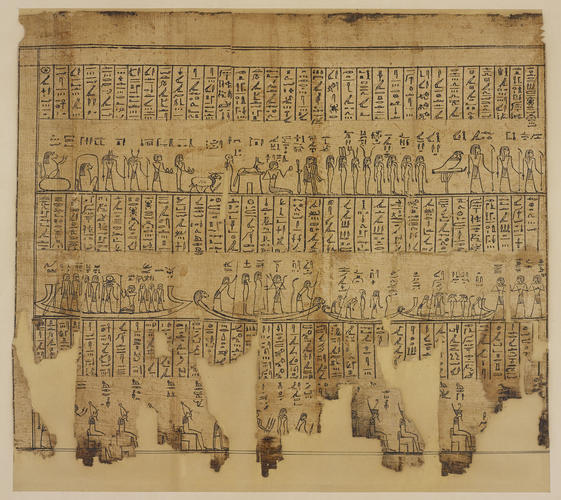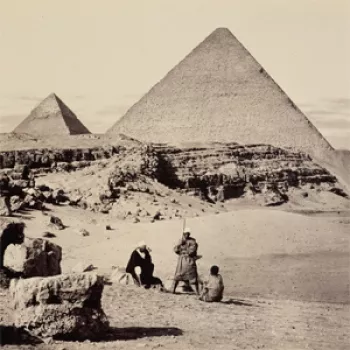Section of the papyrus belonging to Nesmin, with the third hour of the Amduat c.300-275 BC
61.5 x 80.5 cm (mount) (whole object) | RCIN 1145264
-
Section of the papyrus belonging to ‘God’s Father and Prophet of Amun-Ra, King of the Gods, Nesmin, born of the Lady of the House, Sistrum-player of Amun-Ra, Tasherit(en-ta)ihet’ with the third hour of the Amduat (see also RCINs 1145259-66).
The Amduat (literally ‘that which is in the netherworld’), also known as the Book of the Hidden Chamber, is a funerary text that describes the journey of regeneration of Ra, the Egyptian sun god, through the 12 hours of the night from sunset (symbolising death) to sunrise (symbolising rebirth). The text starts appearing in royal tombs from around 1500 BC, and the two most notable examples are perhaps those painted on the walls of the burial chambers of Thutmose III (1479–1425 BC) and Amenhotep II (1427–1400 BC) in the Valley of the Kings, Thebes. It represents an important stepping stone in the literary tradition of ancient Egypt, being the model for later Books of the Afterlife, and it maintains its relevance well into the Graeco-Roman era.
The main aim of the text is to offer a description of the netherworld so that the deceased, as well as the living, are able to gain familiarity with what to expect when their journey into the afterlife begins. Knowledge of the secret paths of the netherworld offers protection to the deceased from the dangers and threats he/she may encounter; the text shows the obstacles and demons that could obstruct a safe passage through the hereafter as well as the deities and beings able to assist and help the deceased towards the completion of the journey of regeneration.
In the third hour, the boat journey is still proceeding through the peaceful, lush and almost paradisiacal region of Wernes. Vegetation can be symbolically linked with the myth and mystery of death and resurrection offered by Osiris, who appears numerous times in this section of the text. He is depicted ten times along the lower register: seated on a throne, four times with the white crown of Upper Egypt and four times with the red crown of Lower Egypt, and twice standing looking backwards (some figures are unfortunately missing because of the lacunose nature of this papyrus but they are known from other versions). The netherworld is clearly Osiris's land but it is with the creative and nourishing powers of the sun god, combined with Osiris's fertility, that regeneration will be made possible at a later stage of the journey.
Ra is depicted, as usual, on his solar barque (Mesektet) on the middle register, accompanied by other gods. The three boats preceding his accommodate gods as well as various forms of the sun god himself, indicating that he is starting his process of transformation. Interestingly, the three boats are protected by a snake god, standing on its tail. The snake is quite an ambivalent symbol in ancient Egypt, as it is sometimes associated with protection, such as in this case where the snake god is warding off the evil forces threatening the sun god, but it is also, as in most cultures, a symbol associated with evil and danger. Apophis, the principal threat to Ra during his journey through the netherworld and the embodiment of evil and of the forces of chaos, is in fact mostly represented as a snake god. The serpent, though, was also regarded as a chthonic creature linked with the process of creation as well as a symbol of renewal and regeneration, in particular when depicted as describing a circle with its tail in its mouth.
Egyptologist Samuel Birch published his study of the papyrus in 1863 (RCIN 1079232). A facsimile was published in 1913 with the hieroglyphic transcripts, translations and an introduction by E.A. Wallis Budge.
A more recent English translation of the complete text of the Amduat can be found in Hornung, E and Abt, T eds, 2007. The Egyptian Amduat. The Book of the Hidden Chamber. Zurich: Living Human Heritage, while a psychological interpretation of the text is presented in Schweizer, A, 2010. The Sungod’s Journey through the Netherworld. Reading the Ancient Egyptian Amduat. Ithaca, NY and London: Cornell University Press.
Provenance
Excavated in Egypt at the Dra' Abu el-Naga' necroplis, near Deyr el-Bahri, part of the larger Theban necropolis, 1862 by Mustafa Aga Ayad, consular agent to the United Kingdom. Acquired by King Edward VII, when Prince of Wales, during his 1862 tour of the Middle East.
-
Measurements
61.5 x 80.5 cm (mount) (whole object)
39.4 x 44.8 cm (sheet of paper)
86.5 x 67.0 cm (book in box)
Category
Alternative title(s)
Passage of the sun through an hour of the night ; 6. (Papyrus of Nas-Khem Priest of Amen-Ra).











